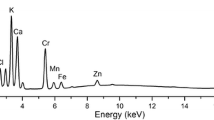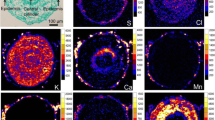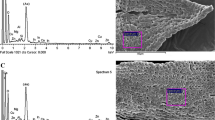Abstract
Chromium pollution of freshwater is hazardous for humans and other organisms, and places a limitation on the use of polluted water sources. Phytoremediation, the use of plants to remove pollutants from the environment, is a cost-effective, environmentally friendly approach for water decontamination. To improve the efficiency of the process, it is essential to increase the current knowledge about Cr accumulation in macrophytes. Plants of Iris pseudacorus L. were treated with Cr(III) at 0.75 mM for 5 weeks to investigate Cr localization by means of transmission electron microscopy and energy dispersive X-ray analysis. Chromium induced severe ultrastructural alterations in the rhizodermis (cell wall disorganisation, thickening, plasmolysis, and electron-dense inclusions) and rhizome parenchyma (reduced cell size, cell wall detachment, vacuolation, and opaque granules). The highest Cr contents were found in the cell walls of the cortex in the roots and in the cytoplasm and intercellular spaces of the rhizome. The Cr concentration in root tissues was in the order cortex >rhizodermis >stele, whereas in the rhizome, Cr was evenly distributed. It is proposed that root and rhizome have distinct functions in the response of I. pseudacorus to Cr. The rhizodermis limits Cr uptake by means of Si deposition and cell wall thickening. The rhizome cortex generates vacuoles and granules where Cr co-occurs with S, indicating Cr sequestration by metal-binding proteins.








Similar content being viewed by others
Abbreviations
- EDX:
-
Energy dispersive X-ray analysis
- PC:
-
Phytochelatins
- TEM:
-
Transmission electron microscopy
- USEPA:
-
United States Environmental Protection Agency
References
Appenroth KJ, Stockel J, Srivastava A, Strasser RJ. Multiple effects of chromate on the photosynthetic apparatus of Spirodela polyrhiza as probed by OJIP chlorophyll a fluorescence measurements. Environ Pollut. 2001;115:49–64.
Barceló J, Poschenrieder C, Gunse B. Effect of chromium-VI on mineral element composition of bush beans. J Plant Nutr. 1985;8:211–7.
Barnhart J. Occurrences, uses, and properties of chromium. Regul Toxicol Pharmacol. 1997;26:S3–7.
Bluskov S, Arocena JM, Omotoso OO, Young JP. Uptake, distribution, and speciation of chromium in Brassica juncea. Int J Phytorem. 2005;7:153–65.
Bringezu K, Lichtenberger O, Leopold I, Neumann D. Heavy metal tolerance of Silene vulgaris. J Plant Physiol. 1999;154:536–46.
Britez RM, Watanabe T, Jansen S, Reissmann CB, Osaki M. The relationship between aluminium and silicon accumulation in leaves of Faramea marginata (Rubiaceae). New Phytol. 2002;156:437–44.
Calheiros C, Rangel A, Castro P. The effects of tannery wastewater on the development of different plant species and chromium accumulation in Phragmites australis. Arch Environ Cont Toxicol. 2008;55:404–14.
Clemens S. Molecular mechanisms of plant metal tolerance and homeostasis. Planta. 2001;212:475–86.
Cobbett C, Goldsbrough P. Phytochelatins and metallothioneins: roles in heavy metal detoxification and homeostasis. Ann Rev Plant Biol. 2002;53:159–82.
Davies FT, Puryear JD, Newton RJ, Egilla JN, Grossi JAS. Mycorrhizal fungi increase chromium uptake by sunflower plants: influence on tissue mineral concentration, growth, and gas exchange. J Plant Nutr. 2002;25:2389–407.
Diwan H, Khan I, Ahmad A, Iqbal M. Induction of phytochelatins and antioxidant defence system in Brassica juncea and Vigna radiata in response to chromium treatments. Plant Growth Reg. 2010;61:97–107.
Duman F, Cicek M, Sezen G. Seasonal changes of metal accumulation and distribution in common club rush (Schoenoplectus lacustris) and common reed (Phragmites australis). Ecotoxicology. 2007;16:457–63.
Elangovan R, Philip L, Chandraraj K. Biosorption of chromium species by aquatic weeds: kinetics and mechanism studies. J Hazard Mater. 2008;152:100–12.
Gupta M, Rai UN, Tripathi RD, Chandra P. Lead-induced changes in glutathione and phytochelatin in Hydrilla verticillata (If) Royle. Chemosphere. 1995;30:2011–20.
Iglesia-Turiño S, Febrero A, Jauregui O, Caldelas C, Araus JL, Bort J. Detection and quantification of unbound phytochelatin 2 in plant extracts of Brassica napus grown with different levels of mercury. Plant Physiol. 2006;142:742–9.
Kotaś J, Stasicka Z. Chromium occurrence in the environment and methods of its speciation. Environ Pollut. 2000;107:263–83.
Krzesłowska M. The cell wall in plant cell response to trace metals: polysaccharide remodelling and its role in defence strategy. Act Physiol Plant. 2010;33(1):35–51.
Kumar AR, Riyazuddin P. Chromium speciation in a contaminated groundwater: redox processes and temporal variability. Environ Monit Assess. 2011;176:647–62.
Labra M, Gianazza E, Waitt R, Eberini I, Sozzi A, Regondi S, et al. Zea mays L. protein changes in response to potassium dichromate treatments. Chemosphere. 2006;62:1234–44.
Lahouti M, Jamshidi S, Ejtehadi H, Rowshani M, Mahmoodzadeh H. X-ray microanalysis and ultrastructural localization of chromium in Raphanus sativus L. Int J Bot. 2008;4:340–3.
Leita L, Contin M, Maggioni A. Distribution of cadmium and induced Cd-binding proteins in roots, stems and leaves of Phaseolus vulgaris. Plant Sci. 1991;77:139–47.
Liang YC, Sun WC, Zhu YG, Christie P. Mechanisms of silicon-mediated alleviation of abiotic stresses in higher plants: a review. Environ Pollut. 2007;147:422–8.
Liu D, Kottke I. Subcellular localization of chromium and nickel in root cells of Allium cepa by EELS and ESI. Cell Biol Toxicol. 2003;19:299–311.
Liu J, Duan CQ, Zhang XH, Zhu YN, Hu C. Subcellular distribution of chromium in accumulating plant Leersia hexandra Swartz. Plant Soil. 2009;322:187–95.
Mangabeira PA, Mielke MS, Arantes I, Dutruch L, Silva DD, Barbier F, et al. Bioaccumulation of chromium in aquatic macrophyte Borreria scabiosoides Cham. & Schltdl. Appl Surface Sci. 2006;252:6816–9.
Marchand L, Mench M, Jacob DL, Otte ML. Metal and metalloid removal in constructed wetlands, with emphasis on the importance of plants and standardized measurements: a review. Environ Pollut. 2010;158:3447–61.
Muramoto S, Aoyama I, Oki Y. Effect of salinity on the concentration of some elements in water hyacinth (Eichhornia crassipes) at critical levels. J Environ Sci Heal A. 1991;26:205–15.
Neumann D, zur Nieden U. Silicon and heavy metal tolerance of higher plants. Phytochemistry. 2001;56:685–92.
Paiva L, Oliveira J, Azevedo R, Ribeiro D, Silva M, Vitoria A. Ecophysiological responses of water hyacinth exposed to Cr3+ and Cr6+. Environ Exp Bot. 2009;65:403–9.
Park D, Yun YS, Jo JH, Park JM. Biosorption process for treatment of electroplating wastewater containing Cr(VI): laboratory-scale feasibility test. Ind Eng Chem Res. 2006;45:5059–65.
Peralta JR, Gardea-Torresdey JL, Tiemann KJ, Gómez E, Arteaga S, Rascon E, et al. Uptake and effects of five heavy metals on seed germination and plant growth in alfalfa (Medicago sativa L). Bull Environ Cont Toxicol. 2001;66:727–34.
Pilon-Smits E. Phytoremediation. Annu Rev Plant Biol. 2005;56:15–39.
Probst A, Liu HY, Fanjul M, Liao B, Hollande E. Response of Vicia faba L. to metal toxicity on mine tailing substrate: geochemical and morphological changes in leaf and root. Environ Exp Bot. 2009;66:297–308.
Qiu S, Huang S. Study on growth and Cd accumulation of root system of Iris pseudacorus seedling under Cd stress. J Plant Res Environ. 2008;17:33–8.
Rabier J, Laffont-Schwob I, Notonier R, Fogliani B, Bouraima-Madjebi S. Anatomical element localization by EDXS in Grevillea exul var. exul under nickel stress. Environ Pollut. 2008;156:1156–63.
Rehman A. Heavy metals uptake by Euglena proxima isolated from tannery effluents and its potential use in wastewater treatment. Russ J Ecol. 2011;42:44–9.
Rodríguez-Llorente ID, Pérez-Palacios P, Doukkali B, Caviedes MA, Pajuelo E. Expression of the seed-specific metallothionein mt4a in plant vegetative tissues increases Cu and Zn tolerance. Plant Sci. 2010;178:327–32.
Roig N, Nadal M, Sierra J, Ginebreda A, Schuhmacher M, Domingo JL. Novel approach for assessing heavy metal pollution and ecotoxicological status of rivers by means of passive sampling methods. Environ Int. 2011;37:671–7.
Rowbotham AL, Levy LS, Shuker LK. Chromium in the environment: an evaluation of exposure of the UK general population and possible adverse health effects. J Toxicol Environ Health B Crit Rev. 2000;3:145–78.
Saha B, Orvig C. Biosorbents for hexavalent chromium elimination from industrial and municipal effluents. Coord Chem Rev. 2010;254:2959–72.
Salt DE, Blaylock M, Kumar NPBA, Dushenkov V, Ensley BD, Chet I, et al. Phytoremediation—a novel strategy for the removal of toxic metals from the environment using plants. Nat Biotechnol. 1995;13:468–74.
Samantaray S, Rout GR, Das P. Role of chromium on plant growth and metabolism. Acta Physiol Plant. 1998;20:201–12.
Sanità di Toppi LS, Fossati F, Musetti R, Mikerezi I, Favali MA. Effects of hexavalent chromium on maize, tomato, and cauliflower plants. J Plant Nutr. 2002;25:701–17.
Shan XQ, Wang HI, Zhang SZ, Zhou HF, Zheng Y, Yu H, et al. Accumulation and uptake of light rare earth elements in a hyperaccumulator Dicropteris dichotoma. Plant Sci. 2003;165:1343–53.
Shanker AK, Cervantes C, Loza-Tavera H, Avudainayagam S. Chromium toxicity in plants. Environ Int. 2005;31:739–53.
Skeffington RA, Shewry PR, Peterson PJ. Chromium uptake and transport in barley seedlings (Hordeum vulgare L.). Planta. 1976;132:209–14.
Turnau K, Henriques FS, Anielska T, Renker C, Buscot F. Metal uptake and detoxification mechanisms in Erica andevalensis growing in a pyrite mine tailing. Environ Exp Bot. 2007;61:117–23.
Vajpayee P, Sharma SC, Tripathi RD, Rai UN, Yunus M. Bioaccumulation of chromium and toxicity to photosynthetic pigments, nitrate reductase activity and protein content of Nelumbo nucifera Gaertn. Chemosphere. 1999;39:2159–69.
Vajpayee P, Rai UN, Ali MB, Tripathi RD, Yadav V, Sinha S, et al. Chromium-induced physiologic changes in Vallisneria spiralis L. and its role in phytoremediation of tannery effluent. Bull Environ Cont Toxicol. 2001;67:246–56.
Van Belleghem F, Cuypers A, Semane B, Smeets K, Vangronsveld J, d’Haen J, et al. Subcellular localization of cadmium in roots and leaves of Arabidopsis thaliana. New Phytol. 2007;173:495–508.
Vinodhini V, Das N. Packed bed column studies on Cr (VI) removal from tannery wastewater by neem sawdust. Desalination. 2010;264:9–14.
Wierzbicka MH, Przedpełska E, Ruzik R, Ouerdane L, Połeć-Pawlak K, Jarosz M, et al. Comparison of the toxicity and distribution of cadmium and lead in plant cells. Protoplasma. 2007;231:99–111.
Yang HJ, Shen ZM, Zhu SH, Wang WH. Heavy metals in wetland plants and soil of Lake Taihu, China. Environ Toxicol Chem. 2008;27:38–42.
Yılmaz S, Türe M, Sadıkoglu M, Duran A. Determination of total Cr in wastewaters of Cr electroplating factories in the I.organize industry region (Kayseri, Turkey) by ICP-AES. Environ Monit Assess. 2010;167:235–42.
Zargar SM, Nazir M, Agrawal GK, Kim DW, Rakwal R. Silicon in plant tolerance against environmental stressors: towards crop improvement using omics approaches. Curr Prot. 2010;7:135–43.
Zhang XB, Liu P, Yang YS, Chen WR. Phytoremediation of urban wastewater by model wetlands with ornamental hydrophytes. J Environ Sci. 2007;19:902–9.
Zhitkovich A. Importance of chromium-DNA adducts in mutagenicity and toxicity of chromium(VI). Chem Res Toxicol. 2005;18:3–11.
Zhou YQ, Huang SZ, Yu SL, Gu JG, Zhao JZ, Han YL, et al. The physiological response and sub-cellular localization of lead and cadmium in Iris pseudacorus L. Ecotoxicol. 2010;19:69–76.
Acknowledgments
This study was part of the International Cooperation European Project MEDINDUS, EC contract no INCO-CT-2004-509159. TEM and LM images were obtained in the TEM Laboratory of the University of Barcelona. X-ray microanalysis was performed in the Microscopy Service of the Autonomous University of Barcelona.
Author information
Authors and Affiliations
Corresponding author
Rights and permissions
About this article
Cite this article
Caldelas, C., Bort, J. & Febrero, A. Ultrastructure and subcellular distribution of Cr in Iris pseudacorus L. using TEM and X-ray microanalysis. Cell Biol Toxicol 28, 57–68 (2012). https://doi.org/10.1007/s10565-011-9205-7
Received:
Accepted:
Published:
Issue Date:
DOI: https://doi.org/10.1007/s10565-011-9205-7




